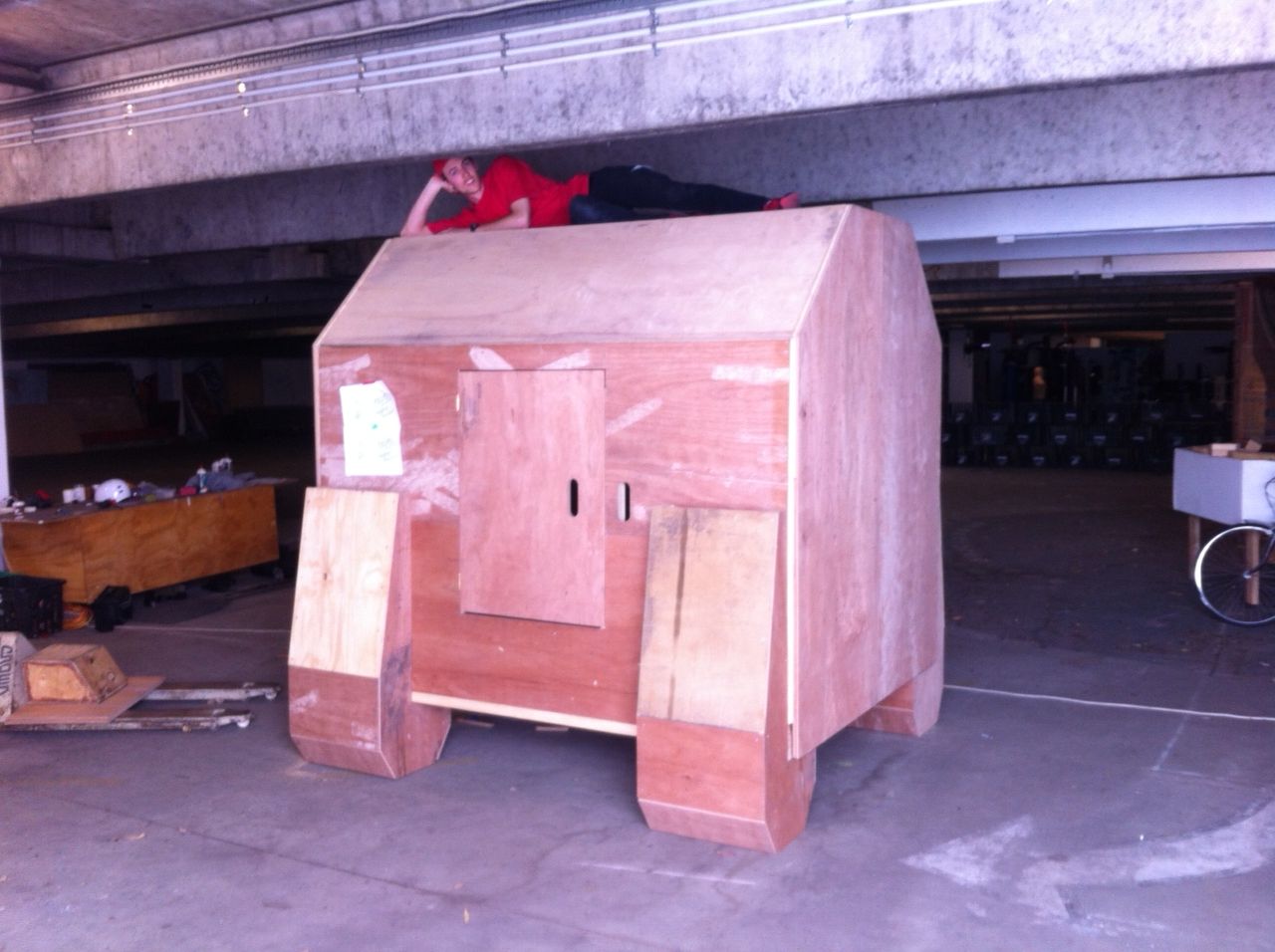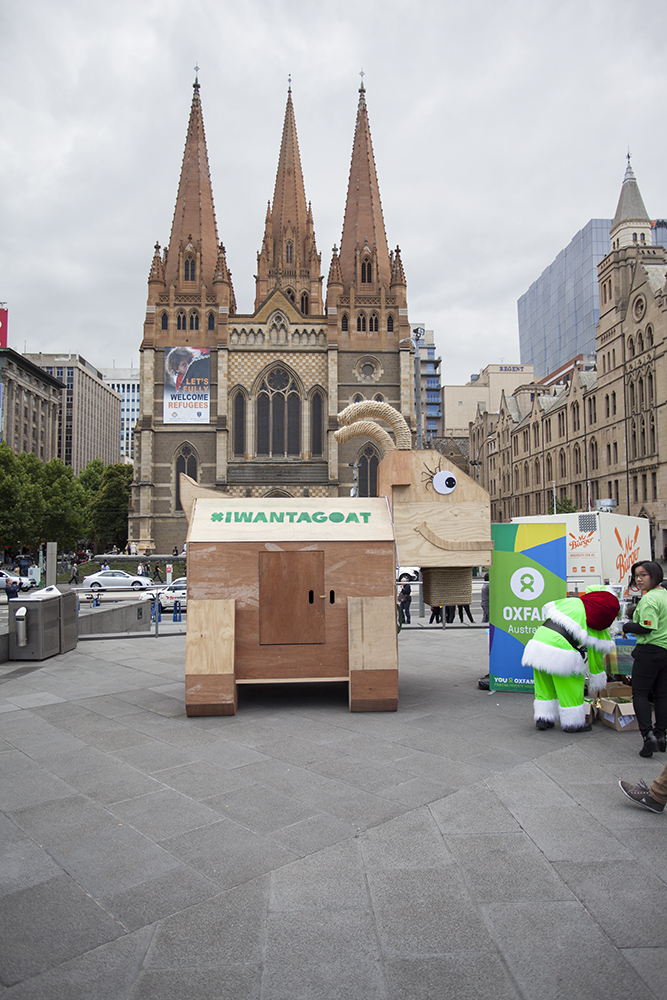
Trojan goat conceals philanthropic design ambition
Share
Of all things, young talent Jesse Badger probably never anticipated being asked to design a goat. Let alone a giant Trojan one built to open up in Federation square, for the purpose of extolling the virtue of giving livestock to needy families during the festive season.
In this Q&A, Badger muses on his recent unexpected project, the potential for design to create social change, and his burgeoning career.
ADR: How did you get involved in building and designing the Oxfam Goat?
Badger: I was working on the Melbourne Bike Cabs Pozible Campaign (successfully funded in October 2014) when a few people from Jack + Bill began working with us. James Kaufman was one of these people and approached me regarding the ‘Oxfam’ brief and we moved forward from there.
What were the key points of inspiration behind the design of the Goat?
I was inspired by chunky geometry and simple shapes. I sketched a lot of two dimensional goat profiles and silhouettes before taking it into a 3-dimensional perspective. For me, I like to stay away from obvious and literal interpretations when designing anything that resembles something found in nature.
Can you give me an idea about the time frame and any challenges you faced during the design process?
From the first day of research to the final day of installation at Fed Square, three months had passed. There are aspects of the final goat I wish were different, but that is to be expected with a short time frame to design, source and construct a giant goat. The most challenging aspect of the whole process was the process of designing the goat in three dimensional software, then transferring that into a physical reality knowing that we had no time to mock up or redo any construction. The digital model had to translate perfectly into the physical world with no error.
How did the Goat’s design encourage community participation and how did the public engage with it/react to it?
The one aspect that makes this Giant Goat particularly unique is the ‘Trojan’ element, being able to open up the goat and enter/emerge for effect which the public enjoyed participating in. I was there the morning we installed the goat and was able to see the very first reactions of the public. To be honest, Melburnians weren’t phased or really surprised to see the giant goat at all. I was approached by many people from overseas who were very curious and intrigued by the meaning behind the goats presence in the square.
What, in your view, was the most successful element of the Oxfam Goat?
If we are talking about physical elements I would say the sheer scale of the goat made it most successful, which is also what made it most challenging. I did receive a lot of positive feedback about the goat tail though – the way it flicked up seemed to really liven up the form.
Can you expand on the potential for design to improve social conditions and foster a sense of community?
The potential for design to accomplish these things is virtually limitless. We are only really limited by our imagination, or in most cases the logistics that get in the way. Design is the forefront of our creative output, using it as a tool to rally community and experiment in social environments will only further improve our ability to implement public design and installations more wisely and effectively.
Can you give a little insight into the challenges and highlights of your job?
The challenge of design is getting the work. The highlight is getting the work. Melbourne is a competitive city for a designer to be working in. If you are less experienced, like I am, it is harder to land those jobs. Design is difficult to leave behind at the end of the day, ideas will be swimming through your head all night and you are constantly problem solving. It is rewarding work though.
Where do you turn for inspiration, and which designers have had the biggest influence on your work?
Where I draw inspiration depends on the project, but on the whole I would say that nature is my most inexhaustible source of inspiration. It is the pure, perfect and ultimate design. Nothing is better. A designer I have always admired is Australia’s own Marc Newson. I discovered his work when I was 16 and have followed his career ever since. Other designers work doesn’t necessarily influence my own, as I look to original organic sources most of the time. Getting caught up in what’s popular and trending can shape your work for the worse.
What excites or frustrates you about the current state of Australian architecture and design?
Melbourne is a stunning city. The heritage buildings and cathedrals in particular are timeless to me. I don’t see timeless modern architecture being erected here though, and that comes down to the selected materials at the end of the day. When you move away from natural materials and into the realm of the synthetic and artificial you notice a difference in how buildings age and change with time. I guess what excites me most about design is simply the limitless potential it has to help people. I would like to see more designers developing solutions for people all over the world, who have real issues. Most design is aimed at the richest %10 percent of the world which I find difficult to stomach. I was pleased to design the Trojan Goat for Oxfam, an ultimately helpful charity.
What has been the proudest achievement in your career?
I am very proud of the work we have done on the Trojan Goat. Seeing the way it is and helping to promote a charitable organisation is heart-warming to witness.
What is your favourite project from your own body of work and why?
I designed a water bottle in my final year at university. It helps school children engage in refilling their bottle to stay hydrated. I installed a water wheel inside the vessel, so there was a positive kinetic response to the bottle refilling. It was a simple and original solution.
What’s next for you, and what are you working on currently?
I am in the process of designing my first furniture series which is exciting. The series will include a stool, shelf and table.


















